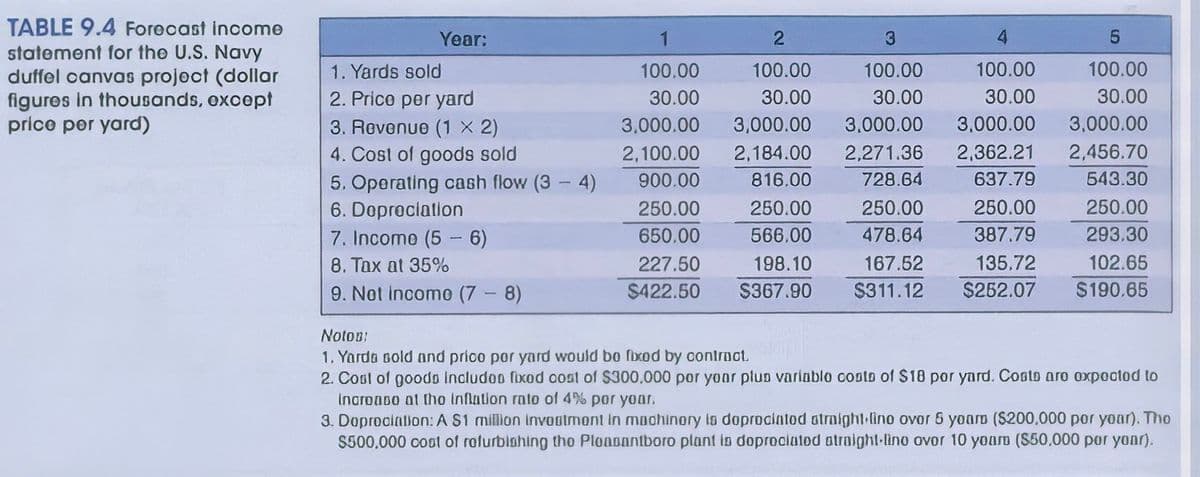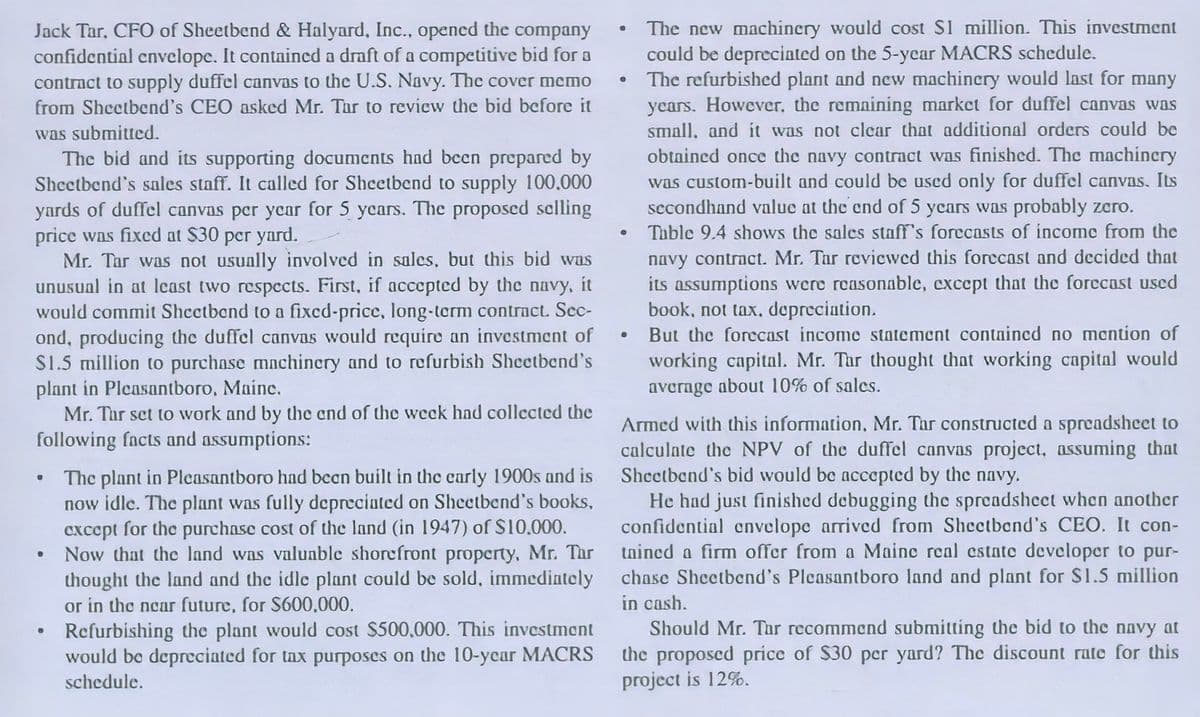TABLE 9.4 Forocast income statement for the U.S. Navy duffel canvas project (dollar figures in thoUsands, except prico per yard) Year: 1. Yards sold 100.00 100.00 100.00 100.00 100.00 2. Prico per yard 3. Røvenue (1 X 2) 4. Cost of goods sold 5. Operating cash flow (3 - 4) 6. Doprociation 7. Income (5-6) 8. Tax at 35% 30.00 30.00 30.00 30.00 30.00 3,000.00 3,000.00 3,000.00 3,000.00 3,000.00 2,100.00 2,184.00 2,271.36 2,362.21 2,456.70 900.00 816.00 728.64 637.79 543.30 250.00 250.00 250.00 250.00 250.00 650.00 566.00 478.64 387.79 293.30 227.50 $422.50 198.10 167.52 135.72 102.65 9. Not incomo (7 - 8) $367.90 $311.12 $252.07 $190.65 Noton: 1. Yardo sold and prico por yard would bo fixod by contract. 2. Cosl of goodo Includoo fixod oost of $300,000 por yonr plun varinblo conto of S18 por yard. Coato aro oxpectod to Incronso at tho Inflation rato of 4% por yoar. 3. Doprocialion: A S1 million invoatmont in machinory io doprocintod atrnight-lino ovor 5 yoarm ($200,000 por yoar). Tho S500,000 coot of rofurbiahing tho Plonontboro plant in doprociatod atraight-lino ovor 10 yoarm (S50,000 por yonr).
TABLE 9.4 Forocast income statement for the U.S. Navy duffel canvas project (dollar figures in thoUsands, except prico per yard) Year: 1. Yards sold 100.00 100.00 100.00 100.00 100.00 2. Prico per yard 3. Røvenue (1 X 2) 4. Cost of goods sold 5. Operating cash flow (3 - 4) 6. Doprociation 7. Income (5-6) 8. Tax at 35% 30.00 30.00 30.00 30.00 30.00 3,000.00 3,000.00 3,000.00 3,000.00 3,000.00 2,100.00 2,184.00 2,271.36 2,362.21 2,456.70 900.00 816.00 728.64 637.79 543.30 250.00 250.00 250.00 250.00 250.00 650.00 566.00 478.64 387.79 293.30 227.50 $422.50 198.10 167.52 135.72 102.65 9. Not incomo (7 - 8) $367.90 $311.12 $252.07 $190.65 Noton: 1. Yardo sold and prico por yard would bo fixod by contract. 2. Cosl of goodo Includoo fixod oost of $300,000 por yonr plun varinblo conto of S18 por yard. Coato aro oxpectod to Incronso at tho Inflation rato of 4% por yoar. 3. Doprocialion: A S1 million invoatmont in machinory io doprocintod atrnight-lino ovor 5 yoarm ($200,000 por yoar). Tho S500,000 coot of rofurbiahing tho Plonontboro plant in doprociatod atraight-lino ovor 10 yoarm (S50,000 por yonr).
Intermediate Financial Management (MindTap Course List)
13th Edition
ISBN:9781337395083
Author:Eugene F. Brigham, Phillip R. Daves
Publisher:Eugene F. Brigham, Phillip R. Daves
Chapter12: Capital Budgeting: Decision Criteria
Section: Chapter Questions
Problem 17P: The Perez Company has the opportunity to invest in one of two mutually exclusive machines that will...
Related questions
Question

Transcribed Image Text:TABLE 9.4 Forecast income
Year:
1
3
4.
statement for the U.S. Navy
duffel canvas project (dollar
figures in thousands, oxcept
price per yard)
1. Yards sold
100.00
100.00
100.00
100.00
100.00
2. Prico per yard
3. Rovenue (1 X 2)
4. Cost of goods sold
5. Operating cash flow (3 4)
6. Doprociation
7. Income (5 - 6)
30.00
30.00
30.00
30.00
30.00
3,000.00
3,000.00
3,000.00
3,000.00
3,000.00
2,100.00
2,184.00
2,271.36
2,362.21
2,456.70
900.00
816.00
728.64
637.79
543.30
250.00
250.00
250.00
250.00
250.00
650.00
566.00
478.64
387.79
293.30
8. Tax at 35%
227.50
198.10
167.52
135.72
102.65
9. Not incomo (7
8)
$422.50
S367.90
$311.12
$252.07
$190.65
Noton:
1. Yardo oold and prico por yard would bo fbod by contract.
2. Cosl of goodo Includoo foxod oost of $300.000 por yoar plun variablo cooto of $18 por yard. Cooto aro oxpootod to
Incronoo at tho Inflation rato of 4% por yoar,
3. Doprociation: A S1 million invoutmont in maohinory io doprocintod otraight-lino ovor 6 yoaro ($200,000 por yoar). Tho
S500,000 coat of rofurbishing tho Ploaoantboro plant in doprociatod atraight-lino ovor 10 yourn (S50,000 por yonr).

Transcribed Image Text:The new machinery would cost S1 million. This investment
could be depreciated on the 5-ycar MACRS schedule.
The refurbished plant and new machinery would last for many
years. However, the remnining market for duffel canvas was
small, and it was not clear that additional orders could be
Jack Tar, CFO of Sheetbend & Halyard, Inc., opened the company
confidential envelope. It contnined a draft of a competitive bid for a
contract to supply duffel canvas to the U.S. Navy. The cover memo
from Sheetbend's CEO asked Mr. Tar to review the bid before it
was submitted.
The bid and its supporting documcnts had bcen prepared by
Sheetbend's sales staff. It called for Sheetbend to supply 100.000
yards of duffel canvas per year for 5 years. The proposed selling
price was fixed at $30 per yard.
Mr. Tar was not usunlly involved in sales, but this bid was
unusual in at lcast two respects. First, if accepted by the navy, it
would commit Shectband to a fixed-price, long-term contract Sec-
ond, producing the duffel canvas would requiro an investment of
S1.5 million to purchase mnchinery and to refurbish Sheetbend's
plant in Pleasantboro, Maine.
obtnined once the navy contract was finished. The machincry
was custom-built and could be used only for duffel canvas. Its
secondhand value at the end of 5 ycars was probably zero.
Table 9.4 shows the sales staffT's forecasts of income from the
navy contract. Mr. Tar revicwed this forecast and decided that
its assumptions were reasonable, cxcept that the forecast used
book, not tax, depreciation.
But the forecast income statement contnincd no montion of
working capital. Mr. Tar thought that working capital would
average about 10% of sales.
Mr. Thr set to work and by the end of the week had collected the
Armed with this information, Mr. Tar constructed a spreadsheet to
calculate the NPV of the duffel canvas project, assuming that
Sheetbend's bid would be accepted by the navy.
He had just finished debugging the spreadsheet when another
confidential cnvelope arrived from Sheetbend's CEO. It con-
tnined a firm offer from a Mainc real cstate developer to pur-
chase Sheetbend's Pleasantboro land and plant for Sl.5 million
in cash.
Should Mr. Tar recommend submitting the bid to the navy at
the proposed price of $30 per yard? The discount rate for this
project is 12%.
following facts and assumptions:
The plant in Pleasantboro had bean built in the carly 1900s and is
now idle. The plant was fully depreciated on Sheetbend's books,
except for the purchase cost of the land (in 1947) of S10.000.
Now that the land was valunble shorefront property, Mr. Tar
thought the land and the idle plant could be sold, immedintely
or in the near future, for S600,000.
Refurbishing the plant would cost $500,000. This investment
would be depreciated for tax purposes on the 10-ycar MACRS
schedule.
Expert Solution
This question has been solved!
Explore an expertly crafted, step-by-step solution for a thorough understanding of key concepts.
This is a popular solution!
Trending now
This is a popular solution!
Step by step
Solved in 2 steps

Knowledge Booster
Learn more about
Need a deep-dive on the concept behind this application? Look no further. Learn more about this topic, finance and related others by exploring similar questions and additional content below.Recommended textbooks for you

Intermediate Financial Management (MindTap Course…
Finance
ISBN:
9781337395083
Author:
Eugene F. Brigham, Phillip R. Daves
Publisher:
Cengage Learning

EBK CONTEMPORARY FINANCIAL MANAGEMENT
Finance
ISBN:
9781337514835
Author:
MOYER
Publisher:
CENGAGE LEARNING - CONSIGNMENT


Intermediate Financial Management (MindTap Course…
Finance
ISBN:
9781337395083
Author:
Eugene F. Brigham, Phillip R. Daves
Publisher:
Cengage Learning

EBK CONTEMPORARY FINANCIAL MANAGEMENT
Finance
ISBN:
9781337514835
Author:
MOYER
Publisher:
CENGAGE LEARNING - CONSIGNMENT


Fundamentals Of Financial Management, Concise Edi…
Finance
ISBN:
9781337902571
Author:
Eugene F. Brigham, Joel F. Houston
Publisher:
Cengage Learning

Managerial Accounting: The Cornerstone of Busines…
Accounting
ISBN:
9781337115773
Author:
Maryanne M. Mowen, Don R. Hansen, Dan L. Heitger
Publisher:
Cengage Learning

Intermediate Accounting: Reporting And Analysis
Accounting
ISBN:
9781337788281
Author:
James M. Wahlen, Jefferson P. Jones, Donald Pagach
Publisher:
Cengage Learning